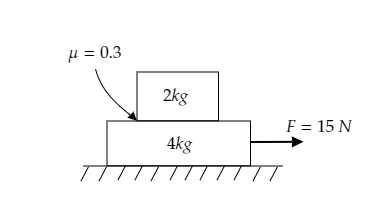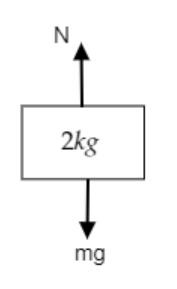
Find the frictional force between the two blocks in the given figure.

A) ${\text{6N}}$
B) ${\text{17}} \cdot {\text{6N}}$
C) ${\text{5N}}$
D) $12{\text{N}}$
Answer
222.6k+ views
Hint: When the force is applied on the lower block of mass, the upper block will slide only when it receives a force greater than the maximum frictional force acting on it. If the two blocks were to slide then they would have a common acceleration and this would be equal to the acceleration of the lower block in the presence of friction.
Formula Used:
The maximum frictional force acting on a block of mass is given by, ${f_{\max }} = \mu N$ where $\mu $ is the coefficient of friction and $N$ is the normal force acting on the block.
The common acceleration of a system of two blocks is given by, ${a_{common}} = \dfrac{F}{{{m_1} + {m_2}}}$ where $F$ is the applied force and ${m_1}$, ${m_2}$ are the masses of the two blocks.
Complete step by step answer:
Step 1: List the parameters obtained from the figure.
The arrangement of two blocks, one on top of the other, on a horizontal surface is given below.

The force applied to the lower block is given to be $F = 15{\text{N}}$ .
The mass of the lower block is ${m_L} = 4{\text{kg}}$ and that of the upper block is given to be ${m_U} = 2{\text{kg}}$ .
The coefficient of friction is $\mu = 0 \cdot 3$ .
Step 2: Express the relation for the common acceleration of the system.
The common acceleration of the given system of two blocks is given by,
${a_{common}} = \dfrac{F}{{{m_U} + {m_L}}}$ -------- (1)
Substituting for $F = 15{\text{N}}$, ${m_L} = 4{\text{kg}}$ and ${m_U} = 2{\text{kg}}$ in equation (1) we get, ${a_{common}} = \dfrac{{15}}{{2 + 4}} = 2 \cdot 5{\text{m}}{{\text{s}}^{ - 2}}$
Thus the common acceleration of the system is ${a_{common}} = 2 \cdot 5{\text{m}}{{\text{s}}^{ - 2}}$.
Step 3: Sketch a figure depicting the forces acting on the upper block and find the maximum friction of the block.

In the above figure, the force of gravity $W = mg$ acts downwards and an equal normal force $N$ acts upwards.
The normal force acting on the upper block will be $N = mg = 2 \times 10 = 20{\text{N}}$ .
Now, the maximum frictional force acting on the upper block is given by, ${f_{\max }} = \mu N$ ------ (2)
Substituting for $\mu = 0 \cdot 3$ and $N = 20{\text{N}}$ in equation (2) we get, ${f_{\max }} = 0 \cdot 3 \times 20 = 6{\text{N}}$
i.e., the upper block will slide only when it receives a force greater than ${f_{\max }} = 6{\text{N}}$ .
When the upper block receives this force its acceleration will be ${a_{\max }} = \dfrac{{{f_{\max }}}}{{{m_U}}} = \dfrac{6}{2} = 3{\text{m}}{{\text{s}}^{ - 2}}$ .
Step 4: Using the obtained value for the maximum friction find the acceleration of the lower block.
As the lower block receives a force $F = 15{\text{N}}$ to slide, the force of friction $f$ will try to oppose the sliding.
Hence the total force acting on the lower block in the horizontal direction will be $F - f$ .
The acceleration of the lower block is given by, ${a_L} = \dfrac{{F - f}}{{{m_L}}}$
$ \Rightarrow f = F - \left( {{a_L} \times {m_L}} \right)$ ------- (3)
The lower block moves with the common acceleration of the system i.e., ${a_L} = {a_{common}} = 2 \cdot 5{\text{m}}{{\text{s}}^{ - 1}}$
Substituting values for $F = 15{\text{N}}$, ${a_L} = 2 \cdot 5{\text{m}}{{\text{s}}^{ - 2}}$ and ${m_L} = 4{\text{kg}}$ in equation (3) we get, $f = 15 - \left( {2 \cdot 5 \times 4} \right) = 5{\text{N}}$
Thus the frictional force between the blocks will be $f = 5{\text{N}}$ .
So the correct option is C.
Note: If the frictional force between the two blocks $f = {f_{\max }} = 6{\text{N}}$ then the acceleration of the lower block would be ${a_L} = \dfrac{{15 - 6}}{4} = 2 \cdot 25{\text{m}}{{\text{s}}^{ - 2}}$ .
But we know that the acceleration of the lower block will be ${a_{common}} = 2 \cdot 5{\text{m}}{{\text{s}}^{ - 2}}$ .
So the frictional force between the blocks, $f \ne {f_{\max }}$ .
Formula Used:
The maximum frictional force acting on a block of mass is given by, ${f_{\max }} = \mu N$ where $\mu $ is the coefficient of friction and $N$ is the normal force acting on the block.
The common acceleration of a system of two blocks is given by, ${a_{common}} = \dfrac{F}{{{m_1} + {m_2}}}$ where $F$ is the applied force and ${m_1}$, ${m_2}$ are the masses of the two blocks.
Complete step by step answer:
Step 1: List the parameters obtained from the figure.
The arrangement of two blocks, one on top of the other, on a horizontal surface is given below.

The force applied to the lower block is given to be $F = 15{\text{N}}$ .
The mass of the lower block is ${m_L} = 4{\text{kg}}$ and that of the upper block is given to be ${m_U} = 2{\text{kg}}$ .
The coefficient of friction is $\mu = 0 \cdot 3$ .
Step 2: Express the relation for the common acceleration of the system.
The common acceleration of the given system of two blocks is given by,
${a_{common}} = \dfrac{F}{{{m_U} + {m_L}}}$ -------- (1)
Substituting for $F = 15{\text{N}}$, ${m_L} = 4{\text{kg}}$ and ${m_U} = 2{\text{kg}}$ in equation (1) we get, ${a_{common}} = \dfrac{{15}}{{2 + 4}} = 2 \cdot 5{\text{m}}{{\text{s}}^{ - 2}}$
Thus the common acceleration of the system is ${a_{common}} = 2 \cdot 5{\text{m}}{{\text{s}}^{ - 2}}$.
Step 3: Sketch a figure depicting the forces acting on the upper block and find the maximum friction of the block.

In the above figure, the force of gravity $W = mg$ acts downwards and an equal normal force $N$ acts upwards.
The normal force acting on the upper block will be $N = mg = 2 \times 10 = 20{\text{N}}$ .
Now, the maximum frictional force acting on the upper block is given by, ${f_{\max }} = \mu N$ ------ (2)
Substituting for $\mu = 0 \cdot 3$ and $N = 20{\text{N}}$ in equation (2) we get, ${f_{\max }} = 0 \cdot 3 \times 20 = 6{\text{N}}$
i.e., the upper block will slide only when it receives a force greater than ${f_{\max }} = 6{\text{N}}$ .
When the upper block receives this force its acceleration will be ${a_{\max }} = \dfrac{{{f_{\max }}}}{{{m_U}}} = \dfrac{6}{2} = 3{\text{m}}{{\text{s}}^{ - 2}}$ .
Step 4: Using the obtained value for the maximum friction find the acceleration of the lower block.
As the lower block receives a force $F = 15{\text{N}}$ to slide, the force of friction $f$ will try to oppose the sliding.
Hence the total force acting on the lower block in the horizontal direction will be $F - f$ .
The acceleration of the lower block is given by, ${a_L} = \dfrac{{F - f}}{{{m_L}}}$
$ \Rightarrow f = F - \left( {{a_L} \times {m_L}} \right)$ ------- (3)
The lower block moves with the common acceleration of the system i.e., ${a_L} = {a_{common}} = 2 \cdot 5{\text{m}}{{\text{s}}^{ - 1}}$
Substituting values for $F = 15{\text{N}}$, ${a_L} = 2 \cdot 5{\text{m}}{{\text{s}}^{ - 2}}$ and ${m_L} = 4{\text{kg}}$ in equation (3) we get, $f = 15 - \left( {2 \cdot 5 \times 4} \right) = 5{\text{N}}$
Thus the frictional force between the blocks will be $f = 5{\text{N}}$ .
So the correct option is C.
Note: If the frictional force between the two blocks $f = {f_{\max }} = 6{\text{N}}$ then the acceleration of the lower block would be ${a_L} = \dfrac{{15 - 6}}{4} = 2 \cdot 25{\text{m}}{{\text{s}}^{ - 2}}$ .
But we know that the acceleration of the lower block will be ${a_{common}} = 2 \cdot 5{\text{m}}{{\text{s}}^{ - 2}}$ .
So the frictional force between the blocks, $f \ne {f_{\max }}$ .
Recently Updated Pages
JEE General Topics in Chemistry Important Concepts and Tips

JEE Extractive Metallurgy Important Concepts and Tips for Exam Preparation

JEE Atomic Structure and Chemical Bonding important Concepts and Tips

JEE Amino Acids and Peptides Important Concepts and Tips for Exam Preparation

Electricity and Magnetism Explained: Key Concepts & Applications

JEE Energetics Important Concepts and Tips for Exam Preparation

Trending doubts
JEE Main 2026: Application Form Open, Exam Dates, Syllabus, Eligibility & Question Papers

Derivation of Equation of Trajectory Explained for Students

Hybridisation in Chemistry – Concept, Types & Applications

Understanding the Angle of Deviation in a Prism

How to Convert a Galvanometer into an Ammeter or Voltmeter

Degree of Dissociation: Meaning, Formula, Calculation & Uses

Other Pages
JEE Advanced Marks vs Ranks 2025: Understanding Category-wise Qualifying Marks and Previous Year Cut-offs

Thermodynamics Class 11 Physics Chapter 11 CBSE Notes - 2025-26

Units And Measurements Class 11 Physics Chapter 1 CBSE Notes - 2025-26

NCERT Solutions For Class 11 Physics Chapter 8 Mechanical Properties Of Solids

Motion in a Straight Line Class 11 Physics Chapter 2 CBSE Notes - 2025-26

Laws of Motion Class 11 Physics Chapter 4 CBSE Notes - 2025-26




